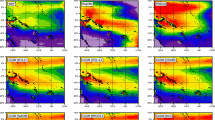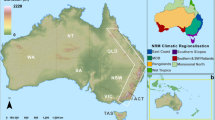Abstract
Simulations of eight different regional climate models (RCMs) have been performed for the period September 1997–September 1998, which coincides with the Surface Heat Budget of the Arctic Ocean (SHEBA) project period. Each of the models employed approximately the same domain covering the western Arctic, the same horizontal resolution of 50 km, and the same boundary forcing. The models differ in their vertical resolution as well as in the treatments of dynamics and physical parameterizations. Both the common features and differences of the simulated spatiotemporal patterns of geopotential, temperature, cloud cover, and long-/shortwave downward radiation between the individual model simulations are investigated. With this work, we quantify the scatter among the models and therefore the magnitude of disagreement and unreliability of current Arctic RCM simulations. Even with the relatively constrained experimental design we notice a considerable scatter among the different RCMs. We found the largest across-model scatter in the 2 m temperature over land, in the surface radiation fluxes, and in the cloud cover which implies a reduced confidence level for these variables.







Similar content being viewed by others
References
ACIA (2004) Impacts of a warming Arctic: arctic climate impact assessment. Overview report. Cambridge University Press, Cambridge, pp 146
Beesley JA, Bretherton CS, Jakob C, Andreas EL, Intrieri JM, Uttal TA (2000) A comparison of the cloud and boundary layer variables in the ECMWF forecast model with observations at SHEBA ice camp. J Geophys Res 105:12337–12349
Box JE, Rinke A (2003) Representation of Greenland ice sheet surface climate in the HIRHAM regional climate model. J Clim 16:1302–1319
Bromwich DH, Cassano JJ, Klein T, Heinemann G, Hines KM, Steffen K, Box JE (2001) Mesoscale modeling of katabatic winds over Greenland with the Polar MM5. Mon Wea Rev 129:2290–2309
Caya D, Laprise R (1999) A semi-implicit semi-Lagrangian regional climate model: the Canadian RCM. Mon Wea Rev 127:341–362
Cassano JJ, Box JE, Bromwich DH, Li L, Steffen K (2001) Evaluation of Polar MM5 simulations of Greenland’s atmospheric circulation. J Geophys Res 106:33867–33889
Christensen JH, Christensen OB, Lopez P, van Meijgaard E, Botzet M (1996) The HIRHAM4 regional atmospheric climate model. DMI Sci. Rep. 96–4, Dan. Meteorol. Inst., Copenhagen, pp 51
Comiso J (2002) Bootstrap sea ice concentrations for NIMBUS-7 SMMR and DMSP SSM/I. National Snow and Ice Data Center, Boulder, Digital media
Covey C, AchutaRao KM, Cubasch U, Jones P, Lambert SJ, Mann ME, Phillips TJ, Taylor KE (2003) An overview of results from the coupled model intercomparison project. Global and Planetary Change 37:103–133
Curry JA, Lynch AH (2002) Comparing arctic regional climate models. EOS Trans Am Geophys Union 83:87
Davies HC (1976) A lateral boundary formulation for multilevel prediction models. Q J R Meteorol Soc 102:405–418
Dethloff K, Rinke A, Lehmann R, Christensen JH, Botzet M, Machenhauer B (1996) A regional climate model of the Arctic atmosphere. J Geophys Res 101:23401–23422
Dethloff K, Abegg C, Rinke A, Hebestadt I, Romanov V (2001) Sensitivity of Arctic climate simulations to different boundary layer parameterizations in a regional climate model. Tellus 53A:1–26
Dudhia J (1993) A nonhydrostatic version of the Penn State - NCAR mesoscale model: Validation tests and simulations of an Atlantic cyclone and cold front. Mon Wea Rev 121:1493– 1513
Giorgi F, Marinucci MR, Bates GT, de Canio G (1993) Development of a second generation regional climate model (RegCM2). Part II: Convective processes and assimilation of lateral boundary conditions. Mon Wea Rev 121:2814–2832
Girard E, Blanchet JP (2001) Microphysical parameterizations of arctic diamond dust, ice fog and thin stratus for climate models. J Atmos Sci 7:1199–1221
Hagemann S, Arpe K, Bengtsson L (2004) Validation of the hydrological cycle of ERA40. Max Planck Inst. for Meteorol., Hamburg
Hodur RM (1997) The Naval Research Laboratory’s coupled ocean/atmosphere mesoscale prediction system (COAMPS). Mon Wea Rev 125:1414–1430
Jacob D (2001) A note to the simulation of the annual and inter-annual variability of the water budget over the Baltic Sea drainage basin. Meteorol Atmos Phys 77:61–73
Johannessen OM, Bengtsson L, Miles MW, Kuzmina SI, Semenov VA, Alekseev GV, Nagurnyi AP, Zakharov VF, Bobylev LP, Pettersson LH, Hasselmann K, Cattle HP (2004) Arctic climate change: observed and modelled temperature and sea-ice variability. Tellus 56A:328
Jones PM, Moberg A (2003) Hemispheric and large-scale surface air temperature variations: An extensive revision and an update to 2001. J Clim 16:206–223
Jones CG, Wyser K, Ullerstig A, Willen U (2004a) The Rossby Centre Regional Atmospheric Climate Model (RCA) PartII: Applicationto the arctic climate. Ambio 33:261–266
Jones CG, Willen U, Ullerstig A, Hansson U (2004b) The Rossby Centre Regional Atmospheric Climate Model (RCA). Part I: Model climatology and performance for the present climate over Europe. Ambio 33
Key J (2001) The cloud and surface parameter retrieval (CASPR) system for polar AVHRR data user’s guide. Space Science and Engineering Center, Univ. of Wisconsin, Madison, pp 62
Køltzow M, Eastwood S, Haugen JE (2003) Parameterization of snow and sea ice albedo in climate models, Research Report 149, Norwegian Meteorological Institute
Laprise R, Caya D, Giguere M, Bergeron G, Cote H, Blanchet JP, Boer GJ, McFarlane NA (1998) Climate and climate change in Western Canada as simulated by the Canadian regional climate model. Atmos Ocean 36:119–167
Lynch AH, Chapman WL, Walsh JE, Weller G (1995) Development of a regional climate model of the Western Arctic. J Clim 8:1555–1570
Lynch AH, Maslanik JA, Wu W (2001) Mechanisms in the development of anomalous sea ice extent in the western Arctic: A case study. J Geophys Res 106:28097–28105
Lynch AH, Curry JA, Brunner RD, Maslanik JA (2004) Toward an integrated assessment of the impacts of extreme wind events on Barrow. Bull Amer Meteor Soc 85:209–221
Martin SE, Munoz E (1997) Properties of the Arctic 2m air temperature for 1979–1993 derived from a new gridded data set. J Clim 10:1420–1440
Morcrette JJ (1990) Impact of changes to the radiation transfer parameterizations plus cloud optical properties in the ECMWF model. Mon Wea Rev 118:847–873
Morrison HC, Shupe M, Curry JA (2003) Modeling clouds observed at SHEBA using a bulk microphysics parameterization implemented into a single-column model. J Geophys Res 108: 4255, Doi:10.1029/2002JD002229
Rinke A, Dethloff K (2000) On the sensitivity of a regional Arctic climate model to initial and boundary conditions. Clim Res 14:101–113
Rinke A, Marbaix P, Dethloff K (2004) Internal variability in Arctic regional climate simulations: Case study for the SHEBA year. Clim Res 27:197–209
Räisänen J (2002) CO2-induced changes in interannual temperature and precipitation variability in 19 CMIP2 experiments. J Clim 15:2395–2411
Serreze MC (2003) Polar products from reanalysis working group, ACSYS Final conference, November, St. Petersburg, Russia
Simmons AJ, Gibson JK (2000) The ERA-40 project plan, ERA-40 Project Rep. Ser. 1, ECMWF, Reading, UK., pp 63
Tjernström M, Zagar M, Svensson G, Cassano JJ, Pfeifer S, Rinke A, Wyser K, Dethloff K, Jones CG, Semmler T (2005) Modeling the Arctic boundary layer: An evaluation of six ARCMIP regional-scale models with data from the SHEBA project. Boundary Layer Meteorol (in press)
Uttal T, coauthors (2002) Surface energy budget of the Arctic ocean. Bull Am Meteorol Soc 83:255–275
Viterbo P (2003) Some aspects of the ECMWF analysis/forecast system in the polar regions. In: Workshop on Short-to-Medium Range Regional NWP in the Arctic and Antarctic, October 8–10, International Arctic Research Center University of Alaska, Fairbanks
Walsh JE, Kattsov VM, Chapman WL, Govorkova V, Pavlova T (2002) Comparison of Arctic climate simulations by uncoupled and coupled global models. J Clim 15:1429–1446
Wu W, Lynch AH, Rivers AR (2005) An approach to estimate uncertainty in a regional climate model. J Clim 18:917–933
Wyser K (1998) The effective radius in ice clouds. J Clim 11:1793–1802
Wyser K, Jones CG (2005) Modeled and observed clouds during surface heat budget of the arctic ocean (SHEBA). J Geophys Res 110: D09207. Doi:10.1029/2004JD004751
Acknowledgments
We are grateful to Randy Reeder who re-processed the original AVHRR data with fitting and filtering procedures to make them adequate for our ARCMIP purpose. We thank Jiping Liu for the discussion about the differences between different observational radiation data sets. We thank Elizabeth Cassano for work connected with the driving data. ERA40 data used in this study have been provided by ECMWF, and Paul Berrisford provided the ERA40 interannual standard deviation data. The atmospheric forcing data for the simulations are also from ECMWF, and are being served by the Joint Office for Science Support (JOSS) at UCAR. The SSM/I and AVHRR data are from National Snow and Ice Data Center, Boulder. AR, KD, CJ, KW, JHC, JEH, and MOK were supported by the European Union project GLIMPSE (EVK2-CT-2002–00164). MT and MZ are supported by the Swedish Research Council and by SWECLIM, and also acknowledge the support from the Naval Reaserch Laboratory, Monterey, USA. Support for JJC, AHL, and MJS was provided by NSF grant OPP-0084291 and OPP-0229649. Data management for ARCMIP and JAC were supported from a grant by NSF/IARC. We are grateful to Ines Hebestadt and Sabine Erxleben for preparing the graphics.
Author information
Authors and Affiliations
Corresponding author
Additional information
An erratum to this article can be found at http://dx.doi.org/10.1007/s00382-006-0157-1
Rights and permissions
About this article
Cite this article
Rinke, A., Dethloff, K., Cassano, J.J. et al. Evaluation of an ensemble of Arctic regional climate models: spatiotemporal fields during the SHEBA year. Clim Dyn 26, 459–472 (2006). https://doi.org/10.1007/s00382-005-0095-3
Received:
Accepted:
Published:
Issue Date:
DOI: https://doi.org/10.1007/s00382-005-0095-3




